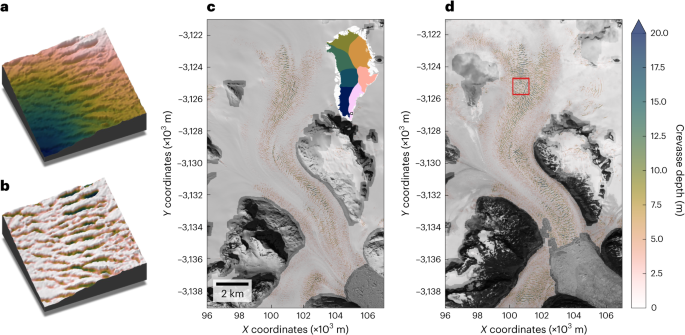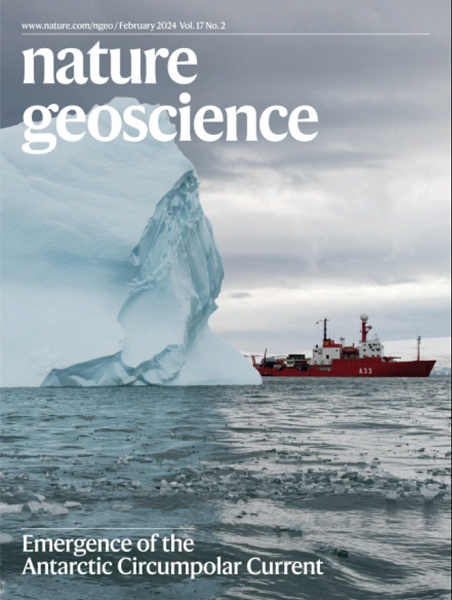Increased crevassing across accelerating Greenland Ice Sheet margins
IF 15.7
1区 地球科学
Q1 GEOSCIENCES, MULTIDISCIPLINARY
引用次数: 0
Abstract
Surface crevassing on the Greenland Ice Sheet is a large source of uncertainty in processes controlling mass loss due to a lack of comprehensive observations of their location and evolution through time. Here we use high-resolution digital elevation models to map the three-dimensional volume of crevasse fields across the Greenland Ice Sheet in 2016 and 2021. We show that, between the two years, large and significant increases in crevasse volume occurred at marine-terminating sectors with accelerating flow (up to +25.3 ± 10.1% in the southeast sector), while the change in total ice-sheet-wide crevasse volume was within measurement error (+4.3 ± 5.9%). The sectoral increases were offset by a reduction in crevasse volume in the central west sector (−14.2 ± 3.2%), particularly at Sermeq Kujalleq (Jakobshavn Isbræ), which exhibited slowdown and thickening over the study period. Changes in crevasse volume correlate strongly with antecedent discharge changes, indicating that the acceleration of ice flow in Greenland forces significant increases in crevassing on a timescale of less than five years. This response provides a mechanism for mass-loss-promoting feedbacks on sub-decadal timescales, including increased calving, faster flow and accelerated water transfer to the bed. Greenland-wide observations of crevasse volume and distribution suggest substantial increases in crevassing between 2016 and 2021 at marine-terminating sectors with accelerating ice flow.


在加速的格陵兰冰盖边缘增加裂缝
格陵兰冰盖上的表面裂缝是控制质量损失过程的一个很大的不确定性来源,因为缺乏对其位置和随时间演变的全面观测。在这里,我们使用高分辨率数字高程模型绘制了2016年和2021年格陵兰冰盖上裂缝场的三维体积。研究结果表明,两年间,在水流加速的终点站区域,裂缝体积显著增加(东南区域增加了+25.3±10.1%),而整个冰盖裂缝体积的变化在测量误差范围内(+4.3±5.9%)。在研究期间,中西部地区的裂缝体积减少(- 14.2±3.2%),特别是在Sermeq Kujalleq (Jakobshavn Isbræ),裂缝体积的增加被抵消了,裂缝体积的减少表现出放缓和增厚。裂缝体积的变化与之前的流量变化密切相关,表明格陵兰冰流的加速迫使裂缝在不到五年的时间尺度上显著增加。这种响应提供了在次年代际尺度上促进质量损失的反馈机制,包括产犊增加、水流加快和水流向河床的加速。
本文章由计算机程序翻译,如有差异,请以英文原文为准。
求助全文
约1分钟内获得全文
求助全文
来源期刊

Nature Geoscience
地学-地球科学综合
CiteScore
26.70
自引率
1.60%
发文量
187
审稿时长
3.3 months
期刊介绍:
Nature Geoscience is a monthly interdisciplinary journal that gathers top-tier research spanning Earth Sciences and related fields.
The journal covers all geoscience disciplines, including fieldwork, modeling, and theoretical studies.
Topics include atmospheric science, biogeochemistry, climate science, geobiology, geochemistry, geoinformatics, remote sensing, geology, geomagnetism, paleomagnetism, geomorphology, geophysics, glaciology, hydrology, limnology, mineralogy, oceanography, paleontology, paleoclimatology, paleoceanography, petrology, planetary science, seismology, space physics, tectonics, and volcanology.
Nature Geoscience upholds its commitment to publishing significant, high-quality Earth Sciences research through fair, rapid, and rigorous peer review, overseen by a team of full-time professional editors.
 求助内容:
求助内容: 应助结果提醒方式:
应助结果提醒方式:


